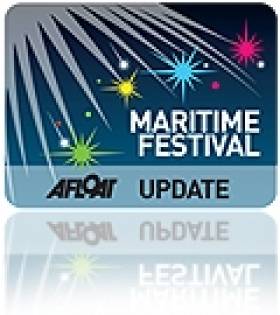Displaying items by tag: Dr John de Courcy Ireland
#PRESIDENT REOPENS MARITIME MUSEUM- President Michael D. Higgins officially performed the reopening ceremony of the €4m restored National Maritime Museum of Ireland in Dun Laoghaire today, reports Jehan Ashmore.
An ecumenical service was held by Canon Victor Stacey, Dean of St. Patrick's Cathedral Dublin, who up until recently was Minister at Christ Church & Mariners in Dun Laoghaire. The Dean was also joined by the town's Rev. Christopher Kennedy from the York Road Presbyterian Church and Mons. Dan O'Connor, Parish Priest of St. Michaels Church.
Follwing the blessing, the President spoke of his admiration for the beautiful building and of those many people over the years that helped to establish the Maritime Institute of Ireland (M.I.I.) and its museum through it many functions and role in the coastal town.
In particular the President paid tribute to the late Dr. John de Courcy Ireland, who was a prominent member of the M.I.I. and was made honorary research officer of the institute which was formed in 1941. It was in that same year that the President remarked was the year of his birth.
Following his speech a plaque to mark the occasion was unveiled by the President on the steps leading up to the altar of the apt venue of the former Old Mariners Church where more than 200 people witnessed the historic occasion. Those in attendance from the diplomatic corps included ambassadors from Argentina, Britain and France.
Among the other dignitaries where the Lord Mayor of Holyhead, local T.D's including Brian Hayes, Minister of State at the OPW which was ultimately responsible in the museum's renovation project. Funding came mostly from the Government, nationwide donations and volunteer-led collections.
The building project included major electrical and fire safety improvements, repairing stain-glass windows, and re-roofing. In addition repointing of the granite-cut building hewn from Dalkey granite which was built in 1836 for the Church of Ireland for mariners. The building is one of the last such structures still intact in the world.
Several years after the church closed in the early 1970' the Maritime Institute of Ireland moved into the building where the museum remained open until 2004.
Since then the building had undergone extensive renovation and modernisation. The museum which has been open to the public since April has exhibits from throughout Ireland and more will be added too in the future according to Peadar Ward, president of the M.I.I.. He added that they look forward to also displaying marine paintings and to hosting lecture programmes in the premises.
Also in attendance where crew members of the Naval Service L.E. Roisin (P51) which made a special port of call to Dun Laoghaire Harbour, berthing along the East Pier.
In addition members of the Irish Naval Association, the local RNLI lifeboat and sea scouts welcomed the President, where the day's events included a planting of an oak tree in the grounds of the building located close to the towns harbour waterfront.
Dr John de Courcy Ireland Remembered at Connemara Maritime Festival
Ireland's leading maritime histortian will be remembered during Conamara Sea Week, which starts next Friday.
The 10-day programme celebrating the west of Ireland's rich maritime heritage kicks off just two days after the centenary of the late Dr John de Courcy Ireland, who tirelessly documented Ireland's relationship with the sea in parallel with a distinguished career as a political activist.
According to The Irish Times, he will be remembered during a conference on 'The Sea as Inspiration' on Saturday 29 October in Letterfrack, Co Galway.
Education and arts are major themes of the maritime festival, which will also feature an exhibition of works from emerging artists.
For more details visit the website of the Conamara Environmental Educational and Cultural Centre at ceecc.org.

























































